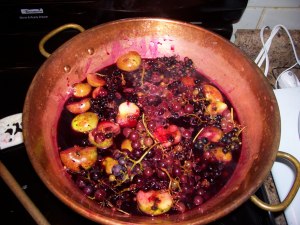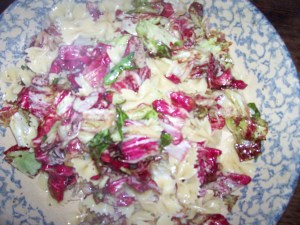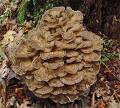
Wild grapes and apples heating up.
One of the great pests of the Ohio, Penna, West Va area is wild grape (
Vitis Labrusca, aka Fox Grape). While it is the primitive form of Concord and Niagara cultivated grapes it is decidedly not cultivated itself. It is cross-pollinated readily among instances and thus has many uncultivated variations. The seeds are spread by bird droppings and new plants grow profusely. It is a pest because of how easily it is spread and it will quickly grow to choke out more valuable trees and shrubs. Its deep roots (seeking the deep limestone of the region) make it as hard to eradicate as any invasive plant there is. But there is a small positive side to the wild grape. It makes terrific jelly … much better than classic grape.
The wild grape does not fruit well since it is seldom pruned for fruiting. It loves to just vegetate (with a vengeance). However, it will often fruit when last year’s vines (grapes fruit on second year wood) find their way to the sun. Walk along wooded trails where the vines have access from the shaded woods (where their roots like the cool humus-rich soil). Roads, railroads, power lines and other wide cuts in the woods are good candidates. The fruit is ready in Mid September. Harvest fruit from as many different vines as possible so that you get a blend of flavors. While you are out, pick some wild apples for pectin or use a very tart cultivated apple … even unripe ones.
You are making a high quality product. Do not use Surejell, Certo or other artificial pectin. If some of the grapes are not fully ripe you will not need artificial pectin in order for the jelly to set. Moreover, artificial pectins require too much additional sugar. Put the grapes (stems and all) and the quartered but unpeeled apples in a heavy pot. Do not clean the fruit … it will purify itself as you make it and you will be straining it. Heat gently until the apples soften. The grapes will have given up their juice but you still need the pectin from the fully cooked apples. This may take a while depending on the hardness of the apples. Sour wild apples are best for pectin but take the longest to soften. When the apples are soft, remove the grape stems from the pot, scraping off the fruit with a dull knife. Sieve the remaining pulp. Hang the sieved pulp in a jelly bag (remember we are after a high quality product so do not ever squeeze the jelly bag! Let it just drip). At this point you can freeze the juice for later processing. Mix four cups of the juice with 4 cups of sugar. ALWAYS do 4 cup batches. (Now comes the art). Heat in a heavy pot or confiture pan until it reaches the jelly point. Use a jelly thermometer or your knowledge of jelly making to know when it is done. Put the jelly into jars and hot-pack process for 20 minutes.
Now comes the hardest part. While the jelly is pretty good jelly right away it is TERRIFIC when it is 3-4 years old. Jelly, especially this jelly, oxidizes slightly in the jar like wine does. Beneficial conversions take place. In 3-4 years your guests will think it is amazingly good but will not know it is grape … because it tastes nothing like Welch’s. It is as complex as a vintage red wine. So make a few batches, some for now and some for “laying down”.
This is a jelly that is especially terrific with either meats, palachinka (eastern European crepes of which there are many variations and spellings depending on the country and culture) or blini. And of course, you can always eat it with peanut butter.




